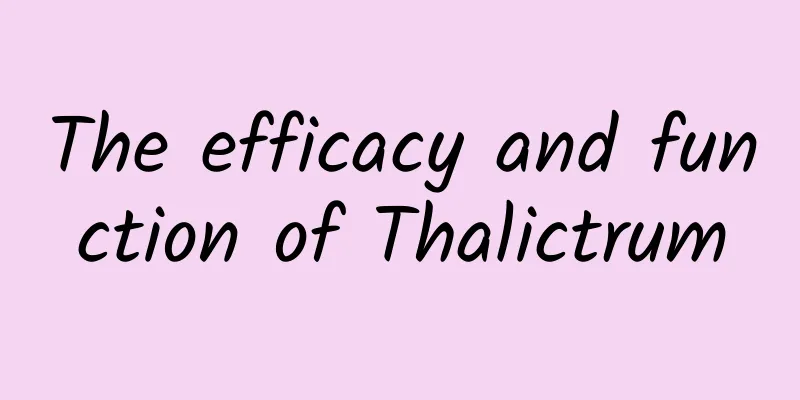The efficacy and function of Thalictrum

|
Speaking of Thalictrum lucidum, many people know that it is a Chinese medicinal material. So do you know the effects and functions of Thalictrum lucidum? How should it be eaten? Let’s find out now. [Other names] White Coptis chinensis, Coptis chinensis, Horsetail chinensis, Coptis chinensis [Source] Medicinal material source: the roots and rhizomes of the Ranunculaceae plant Thalictrum lucidum. [Original form] Perennial herb, 60-150cm tall. The whole plant is hairless. The stem is erect and branched. Leaves are alternate; petioles are 4.5-8cm long and sheathed; stipules are membranous and undivided; basal leaves wither during flowering; stem leaves are three to four times trifoliate; blades are 10-30cm long, leaflets are herbaceous, terminal leaflets are obovate or nearly round, 1.5-2.5cm long, 1.2-3cm wide, with rounded or slightly obtuse apex, base rounded cuneate or rounded, 3 shallowly lobed, lobes entire or with 1-2 teeth; lateral leaflets are mostly oblique cuneate, with slightly raised veins on the back of the leaf; upper leaves are almost sessile. The monochasial cyme is corymbose, much-branched, with numerous densely packed flowers; the flowers are bisexual, with pedicels 4-17cm long, 4 sepals, petal-shaped, broadly elliptic, 3-3.5mm long, white, or lavender, falling from time to time; petals absent; stamens numerous, 6-9mm long, filaments wide at the top and linear at the bottom, anthers oblong, about 1.2mm long, obtuse at the apex; carpels 6-8, with long petioles, short styles, and stigmas born on the ventral side. Achenes are obovate, 4-7mm long, with three broad longitudinal wings, narrowed at the base, 3-5mm long stalk, and very short persistent style. The flowering period is from June to August, and the fruiting period is from July to September. [Habitat distribution] Ecological environment: Grown in grasslands, mountain forest edges or forests at an altitude of 500-1800m. [Cultivation] Biological characteristics: It prefers a cool and humid environment and grows best in loose and fertile sandy loam and humus loam. [Properties] Property identification: There are many reed heads on the top of the dried rhizome, each of which is about 4mm thick, with traces of stem seedlings remaining on the base, and they are often wrapped with thin scaly leaves. The rhizome is long, brown in appearance, with densely bundled fibrous roots on the ventral side, shaped like a horsetail; the fibrous roots are 13-25 cm long, 2-3 mm thick, reddish yellow or golden yellow in appearance, shiny, with longitudinal fine lines. Old cork and cortex often fall off in rings, and those that have not yet fallen off can be rubbed off by hand. It is light, brittle and easy to break. The outer circle of the rhizome cross section is brown, with a yellow woody core inside; the cross section of the fibrous root is dark yellow, with a thin layer of golden bark on the outside. It has a faint smell and a slightly bitter taste. [Chemical composition] The fibrous roots of this product contain berberine, β-sitosterol, N-desmethylthalistyline and 5-O-demethylthalistyline. [Pharmacological action] Berberine has antibacterial effect and is used to treat bacterial dysentery; the total bioalkaloids of Thalictrum baikalense have anti-tumor effect. 【Nature and flavor】 Bitter; cold 【Meridian】 Heart; Liver; Large Intestine 【Functions and indications】 Clears away heat and purges fire; dries dampness and detoxifies. It is used for fever, restlessness, damp-heat diarrhea, lung-heat cough, red and swollen eyes, carbuncle, sore and furuncle. [Usage and Dosage] For oral use: decoction, 5-10g; or made into syrup. For external use: know the dosage, grind into powder and apply on the affected area. 【Preparation】 Pills. [Additional prescription] Ruyi Zhenbao Pills: 35g saffron, 35g cardamom, 35g clove, 35g celery, 35g nigella, 35g gold stone, 35g crab, 35g terminalia, 35g hairy terminalia, 40g licorice, 40g short-spiked rabbit ear grass, 40g frankincense, 40g cassia seed, 40g sunflower, 60g nutmeg, 10g gardenia, 10g grass fruit, 100g pearl, 50g bezoar, 500g yak horn, 50g emblica, 30g musk, 30g white sandalwood, 30g agarwood, 400g red sandalwood, 25g cinnamon bark, 20g magnolia officinalis, 20g green woodruff. 35g of Piper longum and 35g of Alpinia officinalis. Grind it into fine powder, add appropriate amount of water to make pills, and dry. Take once in the morning and evening, 1.5 to 2g each time. Used for stroke-induced neurological pain in the waist and legs, and white vein disease. 【Excerpt】 Chinese Materia Medica After reading the above detailed introduction to the effects and functions of Thalictrum lucidum, I believe many friends have already known the benefits of Thalictrum lucidum. It can be seen that Thalictrum lucidum is very beneficial to our human body. If you need it, you might as well give it a try. |
<<: The efficacy and function of phlegm fire grass
>>: The efficacy and function of Epiphyllum stems
Recommend
The efficacy of drinking water soaked with astragalus and rose
Nowadays, many people like to drink herbal tea. T...
Effects and functions of Cuscuta
Due to the increasing competitive pressure, nowad...
How to distinguish between raw and processed Polygonum multiflorum
Everyone knows that Polygonum multiflorum is a me...
Most people have never tasted the true flavor of cooking oils because they are originally smelly.
Key Points ★ The edible oil we eat does not stink...
Exploring the magical particles of the material world is related to the most precise theories of physics!
Your browser does not support the video tag Autho...
The Analects of Confucius tells us: You can accomplish things without involution!
Mixed Knowledge Specially designed to cure confus...
Friends who are planning to buy an eye protection lamp, don’t panic!
Nowadays, people are paying more and more attenti...
Is long-term consumption of Panax notoginseng powder harmful to the body?
Panax notoginseng powder has the effects of stopp...
Using the atmosphere to make dumpling wrappers? Chinese scientists' latest research is quite amazing!
Chinese scientists recently reported for the firs...
What are the effects and functions of dog whip
I wonder if you have a scientific understanding o...
Do particles have consciousness?
Although we are talking about the smallest substa...
What are blood diseases?
Blood health is very important to people. Once so...
Biejiaruangan tablets
Biejia Soft Liver Tablets are a prescription medi...
The Centers for Disease Control and Prevention issued a reminder! These vegetables must be cooked thoroughly to prevent poisoning!
Summer is hot and rainy, and is a season when bac...
The famous "Central Axis" of Beijing actually hides so many secrets!
The Central Axis of Beijing is the symmetry axis ...









